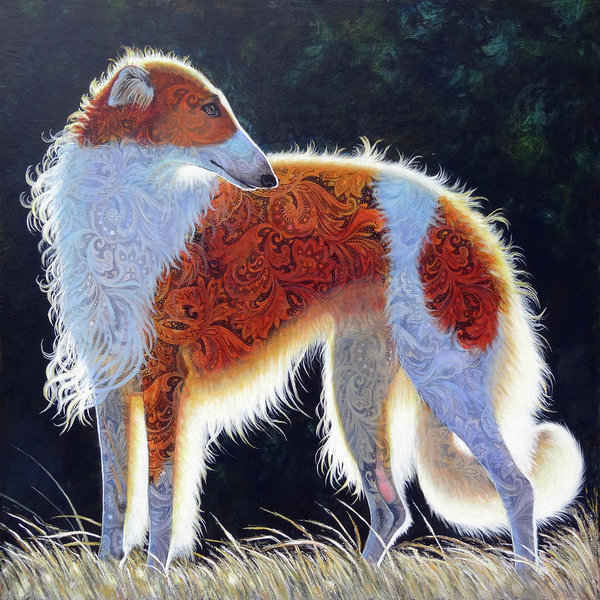
With its clean, elegant lines, it’s little wonder that the Borzoi has been an iconic image in art, and a symbol of glamor (recall the imagery of when a Hollywood starlet of the 1930s emerged from her Rolls Royces with a brace of Russian Wolfhounds). The Borzoi silhouette is unmistakable, in large part because of the breed’s topline – indistinguishable from breed type, and yet the Borzoi standard doesn’t use the word “topline” at all.
To understand this important part of breed type is to understand the breed’s original function as a working sighthound. Its job is to run down and catch wolves, small game, or occasionally, Red Deer, often through very deep snow. To do that, the Borzoi needs to be fast, strong, and flexible. A little rise at the loin leads to a graceful curve, but this is not a cosmetic feature of the dog, it’s an important structural element that provides strength and flexibility for running. Muscular, long loins that are tucked up, combined with a great depth of chest, and a comparatively short, elastic back that gently falls away into the croup allows the transfer of forward motion with efficiency while providing the dog agility and prowess at the turn. The slope of the croup, also part of its iconic silhouette, enables a Borzoi’s thigh muscles to drive with power.
Dr. Anne Midgarden, D.V.M once wrote that her favorite description of a Borzoi was “a winterized Greyhound,” a sighthound with a thick coat to keep warm. Sometimes, however, a well endowed coat can fill in a dog’s curves and make the back look flatter than it really is, and this makes the Borzoi another breed that needs to be “felt” by anyone evaluating a dog. Trimming is discouraged, but some people do it anyway, perhaps out of frustration that their dog’s topline will be misinterpreted. The proof, so to speak, is usually to be discerned through gaiting the dog when a flexible spine and elastic strides reveal themselves.
Understand that this is a simplistic explanation, and that far more goes into the structure of a Borzoi that makes for a sound dog.
Image: “Ablaze In Paisley” by Ande Hall is available as poster, print, mug, and many other format here.

Beautiful artwork.
BTW, Anne Midgarden is a Vet I’ve used for almost 20 years now.
Thanks, Robin, we think it’s beautiful, too! Dr. Midgarden knows her stuff! You’re lucky to have her, we suspect.
I’m not sure Borzoi ever really hunted 3-4 hundred pound red deer. They did hunt wolves but were mainly used along with a foxhound type dog to hunt all manner of game such as hare, fox, etc.
Great job, as always. Love the term, winterized greyhound. That’s what the should be.
Thanks, Elaine, much appreciated!
How can the loin have a little rise and at the same time a back that falls away?
Borzoi hunted small game much more than large game. Promoting the large game myth is why the breed has gotten larger in recent history. Historically they were not as large, on average, as we see today .
Barb, we’re amending the post to reflect that the breed hunted more small game than large because other sources concur, but it DID occasionally hunt red deer. That said, we suspect you’ve taken the post as a detailed anatomical discussion on the breed, something not practical in a post intended to be short, and to be more descriptive (and looking at the back as a whole) than technical since many of our readers are “laymen.” There are wonderful sources on line for a more detailed, in depth look at the Borzoi. As for size, it depends. Some Borzoi folks in the coursing world prefer a smaller dog to be competitive with smaller hounds, others prefer a more substantial dog. We always defer to the breed standard.